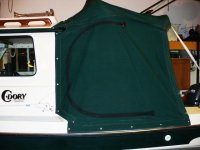There are two types of covers for the back--one is the camper back--which has a full bimini top with frame, and then side and back curtains. The other is a slant back cockpit cover, which is more of a storage cover and keeps debris out of the boat.
I am not sure if the full camper back on a 16 allows standing head room, but I suspect that it does not.
I agree that you have bottom paint. I have been using Petit Vivid for over a year now on one of my boats, and it remains a bright color (I choose a bright blue) and seems to have done well in retaining its anti fouling property when stored on the trailer for 3 months and then gone back in the water.
Good comments on shooting thru the hull. The balsa core, acts as a non conductor of sonic waves, and blocks the ultra sound transmission. You have to have a solid conductor---such as solid glass. If you must have a shoot thru the hull, you can go further forward and take out some flotation under the forward "bunk" or shelf. The core material stops in the 22's and 25's about where the dead rise or V starts to be more pronounced. I don't know for certain in the 16 where the core stops. There is a bit more of a job to put the transducer in so that it is parallel to the water surface--but also far forward may be out of the water under way and I would not advise that location.
Most transducers are put well aft, (at least half way aft) for reasons that there is less turbulence than forward. If you must shoot thru the hull: You can cut out the top glass layer, the core, and then reglass this to be solid glass at any point in the boat. This is a lot of work, and unless you are a good fiberglass worker, there is some risk in doing this. You can purchase flush thru the hull (hole in the hull) transducers. To use these in a cored hull (C Dory) you will drill out the hole the size of the transducer stem. Then undercut the core back about 1/2", with a Dremel tool or allen wrench chucked in a drill. Then fill this area with thickened epoxy and finally smooth out the hole, then do the chamber cut to recess the face of a flush depth sounder into the hull (or a very slight mushroom type of outer face).
The forward looking sonars--are better than they used to be, but my feeling is that they are at their best with steep obstructions--such as a rock ledge, and not a sloping bottom. They are good forward only about 6x to 8x the depth--so if in 30 feet about 180 feet forward,3 feet about 20 feet forward. (However these do not work in less than 3 feet depth). Echo pilot is probably the best and then comes Interphase twin scope, a close second. If you are serious about forward looking sonar, then you can spend a great deal of money with Furuno porfessional gear, and have true underwater radar--which shows very good detail at some range: Starting prices in the $12,000 (as a black box if you already have Furuno displays) and up to $16,000 for dual band dual display. The cheaper Furuno FL 7000 did not prove to be a good product and was dropped by Furuno.

